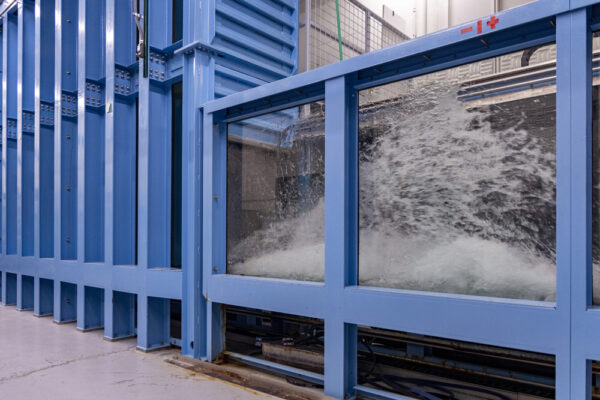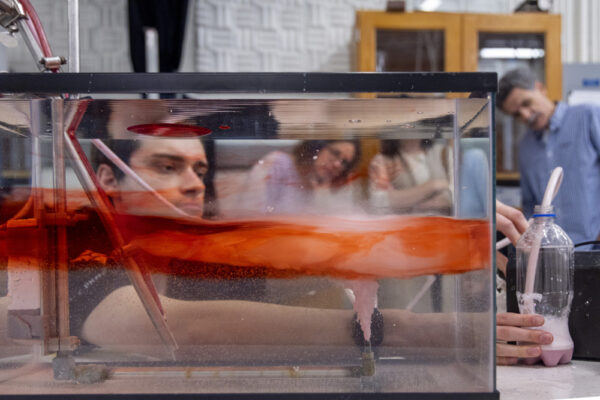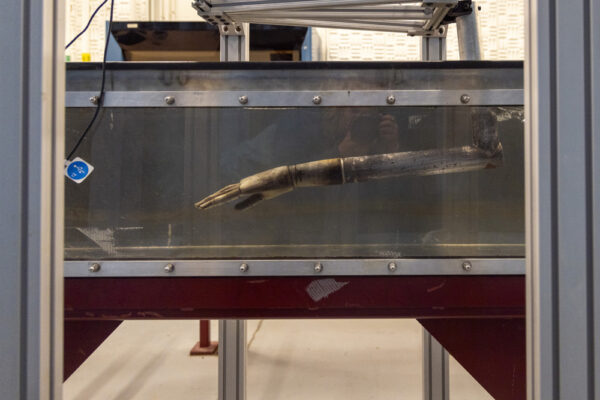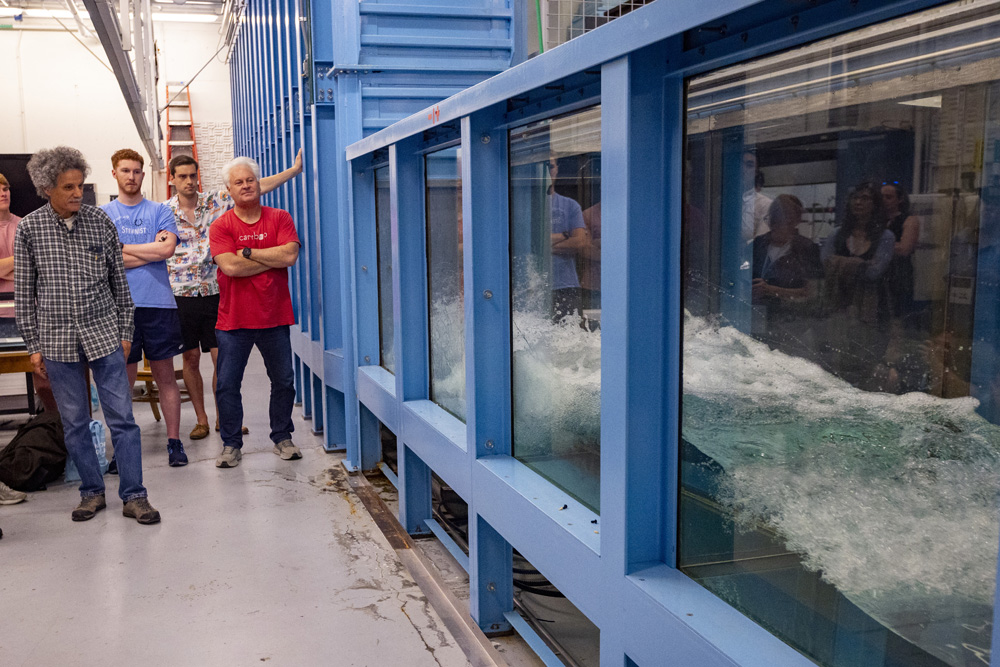When Chapman Hall was being erected on UNC-Chapel Hill’s campus in the early 2000s, the excavators used too much dynamite to create the foundation. They blew out an extra 6,000 square feet of space that was two stories underground.
Anyone who works on a college campus knows that space is limited. Everyone wanted to get their hands on that mistake.
Roberto Camassa and Rich McLaughlin were two of them. The Carolina mathematicians had been using an old kitchen in Phillips Hall to run their fluids experiments. At one point, they built a wave tank that was too big to get through the door, and they ended up removing the jambs to get it into the space.
“When we first saw that space in Chapman Hall, we knew it was ideal for the next-level fluids mechanics research we wanted to do,” Camassa says. “It could fit a long wave tank, and the vibration would be low because it’s underground.”
Camassa and McLaughlin showed face at every meeting about the space.
“I got a phone call from the chemistry chair at the time, who told me that senior leaders aren’t used to young punks like us showing up at every meeting, pounding the tables, yelling for space,” McLaughlin says. “But he also said that if we showed up at the next meeting, hat in hand, we’d get the funding for the space.”
They persisted. At the next meeting, they got the funding to launch the lab.
Today, the Fluids Lab is a safe port for applied mathematicians and interdisciplinary scientists studying physical phenomena, everything from ocean circulation to particulate matter to lung function.
“Not to brag, but I think this is one of the most unique places in the world,” Camassa says.
The lab houses a 118-foot-long wave tank — that’s longer than an NBA basketball court — a wind tunnel, a water channel, an elliptical flume to study sediment transport, a thermal bath, a water-processing facility, and additional tanks for smaller experimental setups.
“So we’re equipped to do pretty much anything,” McLaughlin says. “The smallest scale in our facility is probably a cup of water and the largest is the wave tank [at 13,500 gallons.]”
Finding their flow
Unlike pure mathematicians, who often focus on abstract mathematical concepts, Camassa and McLaughlin are applied mathematicians who combine mathematical modeling and equations with experimentation to explore the physical phenomena that occur in science, engineering, and other disciplines.
Camassa discovered the field through a passion for physics. As a kid in Italy, he read a book about nuclear fusion and became fascinated with the idea of making homemade explosives.
“Nobel Prize winner Richard Feynman had all sorts of ways to classify physicists, like people who built radios when they were kids and people who blew things up. I belonged to the latter category,” Camassa says, chuckling.
While he admits he was never very successful at that — and remains grateful today because he could have gotten hurt — he did go on to study physics at the University of Milan and then engineering science and applied mathematics at the California Institute of Technology (Caltech). During his PhD at Caltech, he worked in the lab of Ted Wu, an expert in fluid dynamics.

The Fluids Lab houses a 118-foot wave tank, increasing the ability to study a variety of water-related phenomena like erosion patterns, oil spill effects, and energy potential. (photo by Megan Mendenhall)
“Ted was an experimentalist who had a facility with a much smaller version of the wave tank that we have now,” Camassa explains.
Meanwhile, on the other side of the world in Arizona, McLaughlin, the son of a physicist-turned-mathematician, was acing his state math tests. After double-majoring in mathematics and music for his undergraduate program, he was torn between pursuing a PhD in math at Princeton and moving to Los Angeles with his band.
“I ended up going to grad school,” he says with a smile, “but I continue to pursue music through bands and solo projects.” In fact, he just released a new record of original piano compositions.
At Princeton, McLaughlin worked with applied mathematician Andy Majda, known for his work on shock waves, combustion, and atmospheric sciences. But it wasn’t until he landed his first faculty position at the University of Utah when he began collaborating with mechanical engineers who had fluid lab facilities, and he got the bug for experimentation.
“There’s a thing that happens in Salt Lake City called a thermal inversion, where the temperature in the bowl in Salt Lake City is very cold compared to the mountains,” he explains. “So you get this really cold, dense air mass. It sits in the bottom of the bowl, nothing really mixes, and you get a lot of smog.”
Those layers of pollution would inspire McLaughlin’s research on stratification, when different layers of the air have different densities — a problem that also applies to the ocean and is something McLaughlin continues to study today at Carolina.
Making waves
Camassa and McLaughlin were recruited to UNC-Chapel Hill in the late 1990s by Greg Forest, a professor in the department who came to Carlina to build the applied mathematics group. The duo had met previously at an academic conference and knew their research goals aligned.
“When I moved here, Roberto and I joined forces and opened a small lab in Phillips Hall,” McLaughlin says. “It was a little shotgun lab that we worked in for the first six or seven years.”
They began their experiments in what they call the “kitchen lab.” At the time, both were studying fluid dynamics, or the movement of liquids and gases. Fluid dynamics can help us understand ocean movement, the forces that affect aircraft, weather patterns, and even how blood, air, and water carry out vital processes in the body.
Their goal has always been to model phenomena and then test it.
“Deriving models is important to isolate what you think is the ultimate reason for an outcome,” Camassa says. “And then you test it to see if you got it right. And then getting it right depends on scale.”

This demo illustrates the lab’s research in stratification and is an example of how oil from the Deepwater Horizon spill became trapped at intermediate depths within the Gulf of Mexico. (photo by Megan Mendenhall)
Small-scale experiments, like what Camassa and McLaughlin were doing in the kitchen lab, are often litmus tests for whether a model is going in the right direction. But to really determine its accuracy, large-scale testing is needed.
“Moving from a fish tank to the ocean is a radical change of scale,” Camassa says. “That’s why having a bigger lab space is important.”
The Fluids Lab in Chapman Hall officially opened its doors in 2007.
Camassa has used the space to study what happens to underwater ocean waves and circulation when fluids of different densities mix — a phenomenon that can cause currents so intense they threaten watercraft and the lives of the people on them. He can study this by filling the wave tank with fluids of different densities and measuring the size of the waves produced.
“The wave tank has a three-meter water column that’s allowed us to study the way mixing occurs in a stratified ocean, which is still a big open question,” Camassa says.
“It also opens new doors to understanding energy recovery from wave fields, how waves destroy seawalls, and how seagrasses are important in preserving coastlines,” McLaughlin adds.
McLaughlin is most excited about their recent project on self-assembly, when multiple components within a system spontaneously come together, in stratified fluids. More specifically, they’re interested in how particles move from the surface to the ocean floor.
While prepping for a lab tour in 2017, a student filled a tank with fluids of different densities to recreate ocean stratification. They made the bottom of the tank too dense, so the experiment didn’t work. The researchers let it sit overnight and, upon returning the next day, some of the particles had fused together into a large disc-like shape.
“It was magic,” McLaughlin says.
Really, it was science.
The Fluids Lab researchers spent the next three years unpacking what occurred. Under normal circumstances, the particles in that tank would have gotten trapped in the denser sections of the water column as they sank — a discovery made by McLaughlin and Camassa two decades ago. But the specific combination of gravity and stratification in the student’s experimental setup created a horizontal force between particles sitting at the same heights, causing them to glom onto one another.
This has the potential to impact how we clean up oil spills, microplastics, and other pollutants in the ocean. Their work was published in Nature Communications in 2019.
“This was probably the most exciting thing I’ve encountered in my career,” McLaughlin says.
Breaking barriers
Mathematicians aren’t the only researchers interested in the Fluids Lab.
Environmental scientists have used the racetrack flume to study how streams filter pollutants and how pollutants affect bank erosion, runoff, and water quality. Biologists have used the wind tunnel to learn how hurricane-force winds impact trees. And a collaborative team of researchers from the College of Arts and Sciences, Eshelman School of Pharmacy, and School of Medicine have used the lab to understand how mucus moves in and out of the lungs.

An early prototype of the hand the researchers created to test swim technique. (photo by Megan Mendenhall)
And now, they are collaborating with exercise and sport scientist Claudio Battaglini on a project to improve swimmer performance for the 2028 Summer Olympics.
An avid swimmer, McLaughlin met Battaglini — the sprint coach for the U.S. National Junior Team — while swimming in Jordan Lake during the pandemic. After learning about the Fluids Lab, Battaglini quickly realized the potential for collaboration.
With help from Carolina computer scientist Jim Mahaney and the UNC Swimming and Diving Team, the lab has created a 3D model of the average-sized hand of a Carolina swimmer. They suspended the hand in a tank to measure how fluid flows around it to determine optimal positions for swimming and are developing a glove to log those positions in real time.
“The Fluids Lab is an applied math space, but we’ve always had an open-door policy,” McLaughlin says. “We want to have people come work in and benefit from the existence of the lab.”


